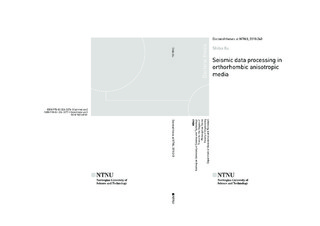| dc.contributor.advisor | Stovas, Alexei | |
| dc.contributor.advisor | Alkhalifah, Tariq | |
| dc.contributor.author | Xu, Shibo | |
| dc.date.accessioned | 2018-09-26T12:42:48Z | |
| dc.date.available | 2018-09-26T12:42:48Z | |
| dc.date.issued | 2018 | |
| dc.identifier.isbn | 978-82-326-3277-0 | |
| dc.identifier.issn | 1503-8181 | |
| dc.identifier.uri | http://hdl.handle.net/11250/2564736 | |
| dc.description.abstract | Describing the directional dependence of the wave velocity, seismic anisotropy has dramatically been gaining attention from both academic and industry, thanks to advances in the wider offset and azimuthal coverage of 3D surveys in the last two decades. Seismic anisotropy is a very useful and important physical property since it can provide the detailed information regarding both kinematic and dynamic processes. In this thesis, we only discuss the influence of anisotropy on the compressional (P) waves since they represent a majority of data being acquired in oil and gas exploration. The kinematic properties of anisotropic media can be defined in the phase and group domains. In the phase domain, these properties are related to the curvatures of the slowness surface computed at the point where both horizontal projections of the slowness vector are zero. In the group domain, the kinematic properties are related to similar curvatures computed from the traveltime (or group velocity inverse) surface at zero offsets.
The overall aim of this thesis is on the behavior of the seismic waves on an anisotropic model and their applications for seismic data processing (e.g. velocity analysis, parameterization, horizontal resolution, geometrical spreading and the imaging problem etc.). Thomsen type parameters are used to represent the anisotropic model. The models tested in this thesis are including: isotropic (ISO), elliptical isotropic (EI), transverse isotropic model with a vertical symmetry axis (VTI), factorized VTI and orthorhombic (ORT) models with an increase of complexity. The acoustic anisotropy assumption is applied for simplification. For multilayered anisotropic models, the effective model parameters derived from the Dix-type equations are used for computation.
The traveltime computation is an important tool in seismic data processing that can be applied for velocity analysis, modeling and time migration. The non-hyperbolicity in moveout caused by anisotropy needs to be taken into consideration, as it commonly exists and plays an important role in seismic data processing and interpretation, especially for large offset. My research is mostly about the derivations of traveltime approximation from the parametric traveltime-offset equation computed through the dynamic ray tracing in VTI and ORT media.
The traveltime-offset equation can also be utilized to compute the radius of the Fresnel zone through the perturbation-based approach for the study of the horizontal resolution. The analytical form of the relative geometrical spreading can be expressed by the traveltime and its derivatives. We propose the approximations for the relative geometrical spreading defined in the generalized non-hyperbolic moveout (GMA) and anelliptic forms and show their superiority of the accuracy compared with the conventional traveltime-based counterparts in the numerical examples in both VTI and ORT models. The accuracy of these approximations is tested in the numerical examples where the exact (standard) solutions are computed from the parametric equations measured through the dynamic ray tracing.
With the help of seismic anisotropy, a high-quality image of the subsurface is obtained. For the multiparameter stacking, the operator for common reflection surface (CRS) involving the anisotropy parameters is derived for a circular reflector in a homogeneous VTI model. The preserved traveltime smoothing (PTS) technique is extended to an ORT model that can be used to smooth the velocity models for prestack depth migration. We develop the formulas for diving waves in a factorized VTI medium and analyze their behavior. The anisotropy parameters are estimated by semblance analysis of the depth migrated data through the imaging moveout formulation (residual moveout after imaging) to update the velocity model that can be used to provide an initial velocity model for the full waveform inversion (FWI). | nb_NO |
| dc.language.iso | eng | nb_NO |
| dc.publisher | NTNU | nb_NO |
| dc.relation.ispartofseries | Doctoral theses at NTNU;2018:243 | |
| dc.relation.haspart | Paper 1: Xu, Shibo; Stovas, Alexey. Curvature and anisotropy estimation through the CRS approximation. Journal of Geophysics and Engineering 2015 ;Volum 12.(6) s. 934-945
https://doi.org/10.1088/1742-2132/12/6/934 | nb_NO |
| dc.relation.haspart | Paper 2: Xu, Shibo; Stovas, Alexey; Alkhalifah, Tariq. Estimation of the anisotropy parameters from imaging moveout of diving wave in a factorized anisotropic medium. Geophysics 2016 ;Volum 81.(4) s. C139-C150
https://doi.org/10.1190/geo2015-0600.1 | nb_NO |
| dc.relation.haspart | Paper 3: Stovas, Alexey; Xu, Shibo. Preserved Traveltime Smoothing on Azimuthally Dependent Orthorhombic Media, Geophysical Prospecting, 65, 1205-1217.
https://doi.org/10.1111/1365-2478.12481 | nb_NO |
| dc.relation.haspart | Paper 4: Xu, Shibo; Stovas, Alexey; Hao, Qi. Perturbation-based moveout approximations in anisotropic media. Geophysical Prospecting 2017 ;Volum 65.(5) s. 1218-1230
https://doi.org/10.1111/1365-2478.12480 | nb_NO |
| dc.relation.haspart | Paper 5: Xu, Shibo; Stovas, Alexey. Three-dimensional generalized non-hyperbolic approximation for relative geometrical spreading. Geophysical Journal International 2017 ;Volum 211, pages 1140-1153
https://doi.org/10.1093/gji/ggx365 | nb_NO |
| dc.relation.haspart | Paper 6: Xu, Shibo; Stovas, Alexey. A new parameterization for acoustic orthorhombic media. Geophysics 2017 ;Volum 82.(6) s. C229-C240
https://doi.org/10.1190/geo2017-0215.1 | nb_NO |
| dc.relation.haspart | Paper 7: Xu, Shibo; Stovas, Alexey; Sripanich, Yanadet. An anelliptic approximation for geometrical spreading in transversely isotropic and orthorhombic media. Geophysics 2018 ;Volum 83.(1) s. C37-C47
https://doi.org/10.1190/geo2017-0038.1 | nb_NO |
| dc.relation.haspart | Paper 8: Xu, Shibo; Stovas, Alexey. Freznel zone in VTI and orthorhombic media. Geophysical Journal International 2018 ;Volum 213.(1) s. 181-193
https://doi.org/10.1093/gji/ggx544 | nb_NO |
| dc.title | Seismic data processing in orthorhombic anisotropic media | nb_NO |
| dc.type | Doctoral thesis | nb_NO |
| dc.subject.nsi | VDP::Technology: 500::Rock and petroleum disciplines: 510::Petroleum engineering: 512 | nb_NO |
